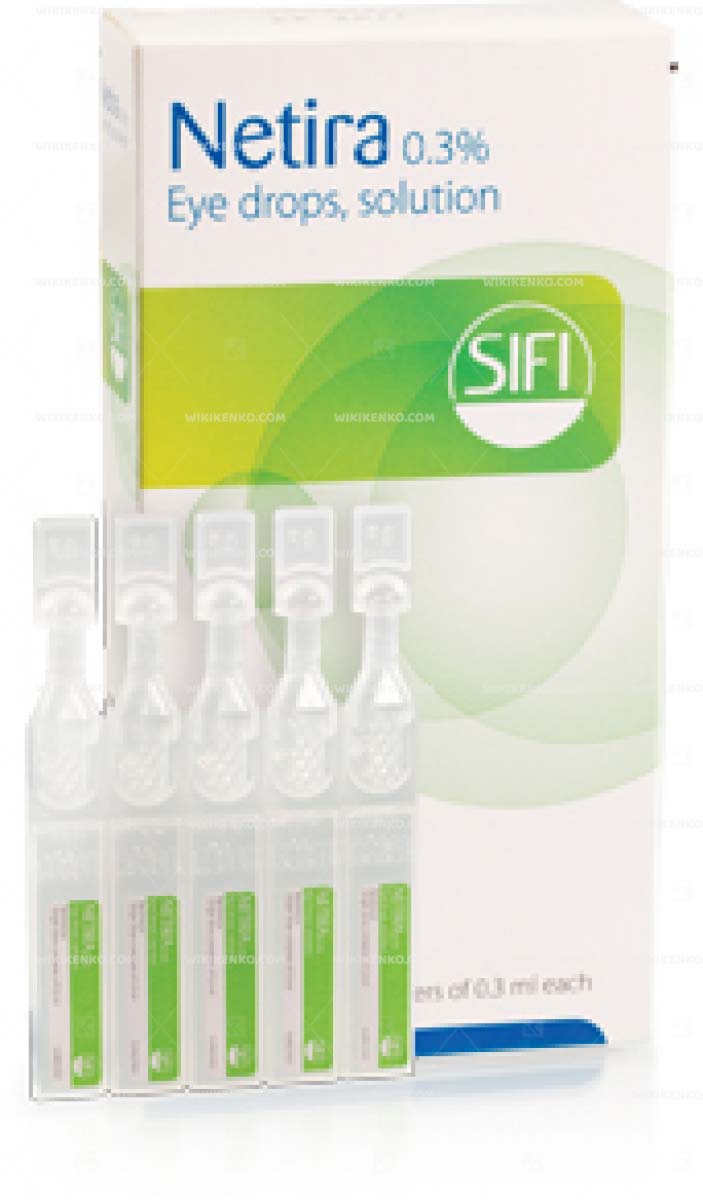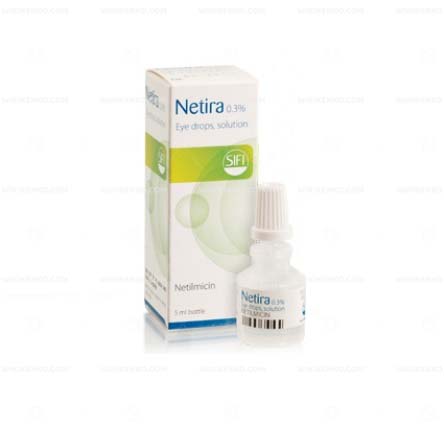Netira Single Dose Eye Drop
| Dosage form | |
|---|---|
| Pack size | |
| Potency | %0.3 15X0.3Ml |
| Manufacturer | |
| Origin | |
| Generic Name (Ingredient) | 100 Ml Of Eye Drops Contain 0.455 G Of Netylmisinsulfate (Equivalent To 0.300 G Of Netilmis). |
Assuming your emergency circumstances for this product, visit Urgent Quotation page. Besides, for any pharmaceutical questions, please ask us in the comments section.
Description
Name of medication
Composition
Therapeutic indications
Bacteremia, septicemia (including sepsis of newborns); severe infectious diseases of the respiratory tract, infections of the kidneys and genitourinary system, skin, soft tissues, bones and joints, burns, wounds, postoperative infections, intraperitoneal infections (including peritonitis), gastrointestinal infections, gonorrhea.
Dosage and Administration
Indications for use: treatment of infectious and inflammatory diseases caused by microorganisms sensitive to the drug:
- Sepsis (including newborns);
- Severe respiratory tract infections;
- Infections of the kidneys and genitourinary tract, incl. acute uncomplicated gonococcal infection in men (urethra, rectum) and in women (urethra, cervix, rectum) with normal kidney function;
- Infections of the skin and soft tissues;
- Infections of bones and joints;
- Burns, wounds, postoperative infection (including preventive treatment);
- Abdominal infections (including peritonitis);
- Gastrointestinal infections.
W/V or V/M.
The doses recommended for intravenous and intramuscular administration are identical. Intravenous administration may be particularly useful in the treatment of patients with septicemia or in shock, as well as patients with congestive heart failure, hematological disorders, severe burns or reduced muscle mass.
To calculate the correct dose, the patient’s body weight should be determined before starting therapy. Doses of aminoglycosides for patients with increased body weight are calculated on the ideal body weight (i.e. without taking into account excess weight of subcutaneous fat).
The average duration of therapy is 7-14 days, in severe infections with complications, a longer course of treatment may be required.
For adults with normal renal function, the recommended dose of Netira for® injection for urinary tract infections or systemic infections of moderate severity is 4.0–6.0 mg / kg / day, divided into 3 equal administrations every 8 hours or 2 injections every 12 hours, or 1 administration per day. In this case, the dose must be adjusted depending on the severity of the infection and the patient’s condition. Adults with a body weight of 50-90 kg, the drug is administered at a dose of 150 mg every 12 h or 100 mg every 8 h. Adult patients with more or less body weight, the dose is set at the rate of 1 mg / kg of ideal body weight.
In severe, life-threatening infections, it is possible to prescribe the drug at a dose of up to 7.5 mg / kg / day, divided into 3 injections every 8 h. The dose in accordance with the clinical situation is reduced to 6 mg / kg / day (usually after 48 hours).
With gonorrhea in men and women, a single intramuscular administration of Netiraa is recommended at a dose of® 300 mg. Injection (use a solution with a concentration of 100 mg / ml) should be done deep into the upper outer quadrant of the gluteal muscle, injecting half the dose into each buttock. For patients with more or less body weight, it is recommended to recalculate the dose based on the ideal body weight.
In uncomplicated urinary tract infections, especially chronic or recurrent course and without signs of renal failure, the drug can be administered intravenously 1 time per day at a dose of 3 mg / kg for 7-10 days.
For children, the drug is prescribed depending on age. Newborns (including premature babies) at the age of 1 week or less dose is set at the rate of 6 mg / kg / day (3 mg / kg / administered every 12 hours). Children aged 1 week to 1 year – from 7.5 to 9.0 mg / kg / day (2.5-3.0 mg / kg administered every 8 hours). Children older than 1 year – from 6.0 to 7.5 mg / kg / day (2.0-2.5 mg / kg is administered every 8 hours).
When combined with other antibiotics, the doses of the drug recommended for patients with normal or impaired renal function should not be changed.
In patients with impaired renal function, monitoring of the concentration of netilmicin in the blood serum is necessary to correct the dosing regimen. If this is not possible, and the condition of the kidneys is stable, for dose adjustment, it is most reliable to focus on creatinine clearance (CC) and the creatinine content in the blood serum.
One way to adjust the dosing regimen is to increase the interval between administrations in the average recommended doses. To do this, the interval between injections (in hours) is determined by multiplying the serum creatinine level (mg / 100 ml) by 8.
In patients with severe infections and impaired renal function, more frequent administration of an antibiotic may be required, but in a reduced dose.
After the administration of the average initial or loading dose to determine the reduced dose when administered every 8 hours, it is possible to divide the value of the average dose by the value of creatinine in the blood serum (see Table).
If QC is known, then the maintenance dose administered every 8 hours is determined by the formula:
Maintenance dose = Observed QC/Normal QC × Standard maintenance dose.
The initial or loading dose corresponds to the recommended for patients with normal renal function.
Table
| Serum creatinine level, mg/100 ml | Approximate QC value, mg/min/1.73 m2 | Percentage of standard dose |
| ≤1 | >100 | 100 |
| 1,1–1,3 | 70–100 | 80 |
| 1,4–1,6 | 55–70 | 65 |
| 1,7–1,9 | 45–55 | 55 |
| 2,0–2,2 | 40–45 | 50 |
| 2,3–2,5 | 35–40 | 40 |
| 2,6–3,0 | 30–35 | 35 |
| 3,1–3,5 | 25-30 | 30 |
| 3,6–4,0 | 20–25 | 25 |
| 4,1–5,1 | 15–20 | 20 |
| 5,2–6,6 | 10–15 | 15 |
| 6,7–8,0 | <10 | 10 |
The above dosage regimens are indicative and are used in cases where it is impossible to determine the level of netilmicin in the blood serum.
With a deterioration in renal function during the therapy, an additional dose reduction may be required.
When conducting hemodialysis for adults, the recommended dose of the drug for administration at the end of the dialysis procedure is 2 mg / kg; children – from 2 to 2.5 mg / kg, depending on the severity of the infection.
Rules for the preparation and administration of the solution for intravenous administration
For intravenous administration to adults, the required dose of the drug is diluted in 50-200 ml of sterile 0.9% sodium chloride solution or 5% aqueous dextrose solution; for children and infants, the volume of the solvent depends on the patient’s need for fluid. The resulting solution is administered drip for 0.5-2 h. In some cases, it is allowed to introduce the solution into a vein or into a
venous catheter slowly for 3-5 minutes.
Contraindications
Hypersensitivity.
Side effects
From the nervous system and sensory organs: headache, malaise, disorientation, paresthesia, visual impairment, vestibular and cochlear function.
From the cardiovascular system and blood (hematopoiesis, hemostasis): tachycardia, hypotension, palpitations, thrombocytosis, leuko-, thrombocytopenia, anemia, increased prothrombin time.
From the gastrointestinal tract: vomiting, diarrhea, impaired liver function, hyperglycemia.
Other: rash, chills, fever, impaired renal function, fluid retention in the body, hyperkalemia; soreness at the injection site; allergic reactions.
Pharmacodynamics
It is highly active against gram-negative microorganisms: Escherichia coli, Klebsiella spp., Enterobacter spp., Serratia spp., Shigella spp., Salmonella spp., Proteus spp., Citrobacter sp., Proteus spp. (indolositive and indol-negative), Proteus mirabilis, Proteus vulgaris, Morganella morganii, Providencia rettgeri, Pseudomonas aeruginosa and Neisseria gonorrhoeae and some gram-positive microorganisms, in particular Staphylococcus spp. (strains that produce and do not produce penicillinase, as well as methicillin-resistant strains).
Pharmacological group
- Aminoglycosides
Interaction
Nephro- and ototoxicity are enhanced by other drugs that affect the kidneys (for example, cephalosporins) and the auditory apparatus (for example, ethacrynic acid, furosemide). Muscle relaxants and anesthetics increase the risk of developing neuromuscular blockade and respiratory paralysis.
Origin
Use the form below to report an error
Please answer the questions as thoroughly and accurately as possible. Your answers will help us better understand what kind of mistakes happen, why and where they happen, and in the end the purpose is to build a better archive to guide researchers and professionals around the world.
The information on this page is not intended to be a substitute for professional medical advice, diagnosis, or treatment. always seek the advice for your physician or another qualified health provider with any questions you may have regarding a medical condition. Always remember to
- Ask your own doctor for medical advice.
- Names, brands, and dosage may differ between countries.
- When not feeling well, or experiencing side effects always contact your own doctor.
Cyberchondria
The truth is that when we’re sick, or worried about getting sick, the internet won’t help.
According to Wikipedia, cyberchondria is a mental disorder consisting in the desire to independently make a diagnosis based on the symptoms of diseases described on Internet sites.
Why you can't look for symptoms on the Internet
If diagnoses could be made simply from a textbook or an article on a website, we would all be doctors and treat ourselves. Nothing can replace the experience and knowledge of specially trained people. As in any field, in medicine there are unscrupulous specialists, differences of opinion, inaccurate diagnoses and incorrect test results.





Reviews
There are no reviews yet.